The Earth Is My Witness
Air Date: Week of November 10, 2017
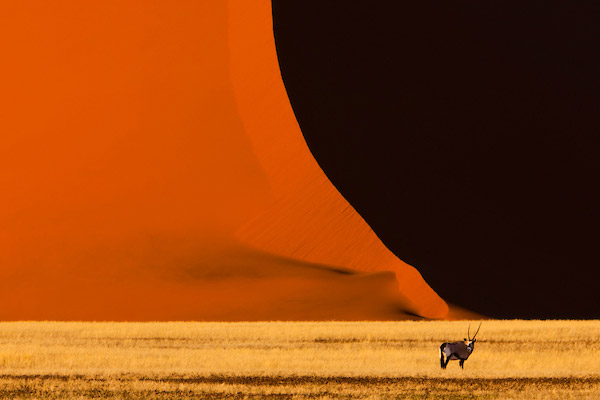
A gemsbok idles in Namib-Naukluft National Park in Namibia. Wolfe’s most recent photography collection is structured according to biome, with chapters highlighting mountains, oceans, and deserts, among others. (Photo: Courtesy of Art Wolfe)
The duty of any photojournalist who documents the natural world must be to conserve and protect it, while reflecting it with a creative and sympathetic eye, notes photographer Art Wolfe. After forty years of traveling the world and capturing natural wonders he has published a visually stunning book, The Earth is My Witness, which features an expansive and beautiful photo collection that documents climate change and the world’s most threatened traditional cultures. Art Wolfe joins host Steve Curwood to shine a light on the power of pictures and how they speak to us.
Transcript
CURWOOD: It’s Living on Earth, I’m Steve Curwood.
A picture, they say, is worth a 1,000 words, though in radio we always hope our words help your mind create better pictures than any you might actually see on a page. But the game changes when the image is art, and art, dare I say fine art is the essence of the gorgeous book “Earth Is My Witness”. It is the result of 40 years of travelling the globe, camera in hand, by artist-turned-photographer Art Wolfe. He’s on the line now from Seattle. Art, welcome to Living on Earth.
WOLFE: Thank you. I’m happy to be here.
CURWOOD: So, here you have this absolutely stunning book loaded with photographs and from your story that's in the book, I gather you started with a [Kodak] Brownie camera as a kid?
WOLFE: Brownie Fiesta, that was my first camera. [LAUGHS]
CURWOOD: [LAUGHS] And your family, I guess your folks were artists, making their living with art, and you thought you would be an artist as well I gather.
WOLFE: You know that's exactly what it was. As a young man I had two great loves, going out into the forest with a little bird book, mammal book, tree book, and I was a naturalist without even knowing the word ‘naturalist’, and I studied them and I memorized them, and they've stuck with me all these years. But the other thing that I loved to do was to draw and paint, and my mother took a correspondence course in drawing and painting, and I had my little easel, and I’m right there watching her, and I must have been around five, six, and seven during that period of time. So, it was ingrained early on, both art and nature.
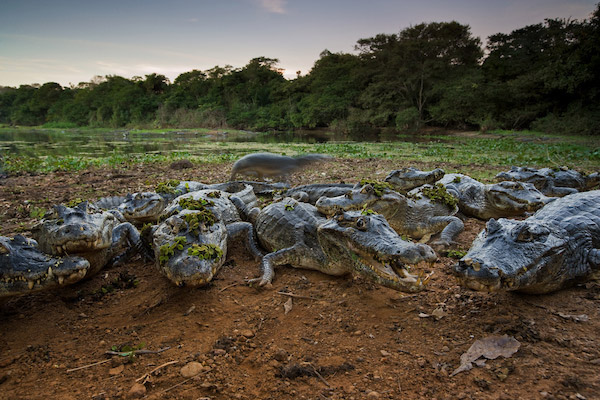
Uruguayan caiman emerge from a wetland in Brazil’s Pantanal. As Wolfe says, these five-foot-long reptiles are accustomed to humans feeding them, so they aren’t afraid to approach a photographer. (Photo: courtesy of Art Wolfe)
CURWOOD: So, at some point you decide that the pen, the pencil, was maybe a little less effective than what you could do with the camera. Why?
WOLFE: Actually it's a really curious evolution because all through grade school, junior high, high school, and then into college, I always focused on art, and in fact I wound up getting a degree in painting, fine art painting at the University of Washington. But during college years whatever I was learning about composition and esthetics of art I was applying to my burgeoning photography career. So, there was this parallel life, one during the week studying artand Matisse and Jackson Pollock and all the history of art, and on weekends I'd be doing the other great love which was pursuing nature and climbing the mountains, and suddenly the camera became part of the journey, initially just to capture the scenes to show my family and friends where I will gone on weekends. But they responded, and I was responding at the same time, learning composition and painting applied to photos.
CURWOOD: Art, you named your book “Earth Is My Witness”. Why did you pick that title and what does it mean?
WOLFE: It is a excerpt from a Buddhist prayer, and I think what it means is the Earth is watching and always watching what we as humans are doing, and I think it’s very prophetic in today's world.
CURWOOD: What does "Earth Is My Witness" mean to you?
WOLFE: You know, over 40 years as I have traveled, it's hard to pin down the genre of my work. I photograph abstracts in major cities. I photograph indigenous cultures. I photograph wildlife and landscapes. So, virtually everything is of interest to me, and so over a 40 year career, I think “Earth Is My Witness” is a testament to what I've seen and what I've experienced on a global scale that I've just absorbed over the years.
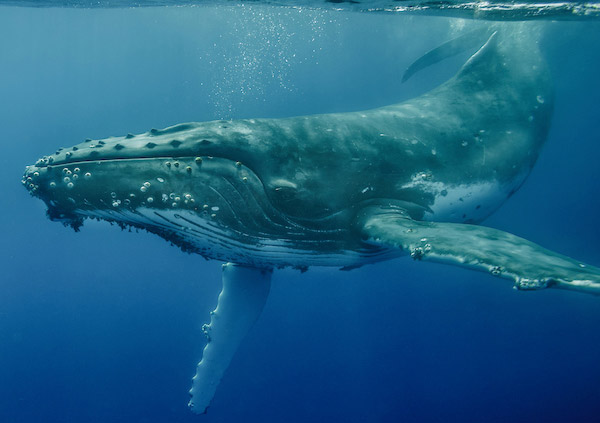
A Humpback whale submerges in the Pacific Ocean, near Tonga. Tonga and the Dominican Republic, Wolfe explains, are the only countries in the world in which it’s legal to snorkel with these massive creatures. (Photo: courtesy of Art Wolfe)
CURWOOD: Art, well, you say you have no particular genre, but I think one of the most exciting things you do is you take color right to the edge of the most saturation that the medium will allow, and it's really a lot of fun.
WOLFE: Well, thank you. I think we have historically used films that were not as rich as what we actually see in the real world. When I'm looking out this window..For instance right now, I've got Japanese maples that are a riot of red. But historically when we would use Kodachrome film it was more of a great palette of reds and greens, and so consequently I don't know that our brains are translating the color as rich as it is. Having said that, now in the age of digital, you have to use a certain amount of contrast and saturation to restore it to the color that it was. I just want the images in the book to be crisp, clean, and vibrant like the paintings I used to do as well.
CURWOOD: How fair is it to say that you find color exciting?
WOLFE: Well, I teach color. You know, I teach a lot of classes around. I love using complementary colors, and I talk about the theory of color and how famous artists like Claude Monet and other people use complementary colors in close juxtaposition to create excitement to their rods and cones in our eyes, and so I use color judiciously. I get up early. I stay out late. I use the light. I often use very subdued color to bring out the saturation and the richness of the environment. I avoid noonday light which makes really high contrast, high key photos, so I'm trying to do the best I can in capturing a subject in the best light and the best color.
CURWOOD: I want to talk to you about journalism versus art. Where do you put your photos along that spectrum?

A lone Gentoo Penguin peers out over the water and melting ice of Antarctica. Art Wolfe considers himself an advocate for conservation and seeks to capture the impacts of climate change in his work. (Photo: courtesy of Art Wolfe)
WOLFE: I think that they encompass both. You know, I love nothing more than to go into a remote village along the Sepik River in New Guinea or into the deserts of Ethiopia or wherever it may be, the hill tribes of Southeast Asia, and capture a tribe and their quality of life before the inevitable creep of Western civilization. So, I want to capture those traditions before they're gone. I purely look at that as a journalistic style and drive, but I'm going to also do it in as eloquent and artistic way I can. I'm not simply aiming the camera at a subject, I'm framing the shot. I'm thinking about the backdrop. I'm trying to capture the subject in a way that has an emotional connection to the audience. If I can't make that emotional connection to the audience, they're going to move on, and so it's all about communicating what inspired me, what I'm seeing, and paying homage to that.
CURWOOD: So, you write in your book at one point that there's this perception that photography is real and whatever you aim the camera at is a pure recording of reality, and you don't agree with that.
WOLFE: It is simply not true. It has never been true. You as a photographer instantly start putting your own slant on a photo, and journalists which have to abide by the most stringent of ethics still have powerful ways of telling their stories, and they may include or exclude things that distract from what they're trying to tell, but they're altering their reality by what they choose to include or not, whether they use a wide angle or whether they use a telephoto lens to compress the scene, they are making choices that changes the actual reality of the situation, and their goal is still making some sort of esthetically strong, graphic image out of the subject.
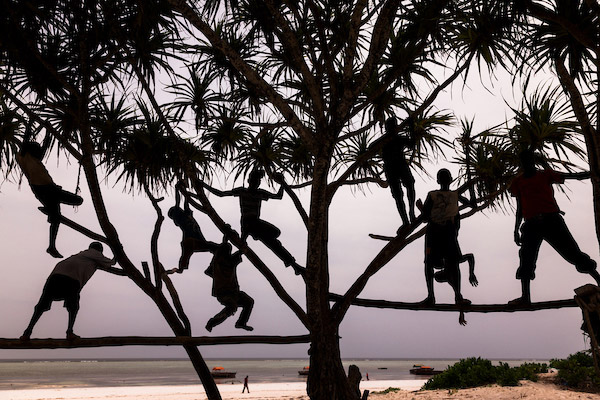
Children play in a tree in Zanzibar, Tanzania. To get this candid shot, Art Wolfe says, he had to hide and approach cautiously – when the kids saw him, they would smile and pose. (Photo: Courtesy of Art Wolfe)
CURWOOD: You say you became a cultural photographer when you were up on Mount Everest. Tell us that story please.
WOLFE: Yeah, you know, in the '50s I was growing up and in the '60s I was very aware that Tibet, nobody knew what was going on in Tibet. When the offer to came through my friends to join them as expedition photographer, I seized the moment not because I ever grew up with dreams of being up on Mount Everest. I wanted to see Lhasa. I wanted to see what the Tibetan people were like, and so I joined the expedition and spent three months up on the mountain. Went from 16,000 to 25,000 thousand feet to the North Col, I never planned on being a high altitude climber, but North Col is pretty high. Then it was the yak drivers, the villagers that were down valley that were of intrigue to me, and when I first started photographing the cultures that lit a light in me, and I thought, “My God, if I survive this expedition, I'm going to travel as fast and furious as I can,” because we saw the first little tiny black and white TVs in some of the villages outside of Lhasa, and it's like, wow, the light of that TV is analogous to a freight train coming their way.
CURWOOD: Let's talk a bit about your involvement with subjects. At the very beginning of your book you have a spread. It's actually over two big pages of a humpback whale that you photographed in Tonga. What was it like being in the water with this, well, it’s a huge animal?
WOLFE: It is a huge animal. I've spent a lot of time with whales in Southeast Alaska, but I have never been in the water with them, and so I went to Tonga because Tonga, like the Dominican Republic, are the only two countries in the world that permit getting into the water with humpback whales and you're only allowed to snorkel. So, the whale has total decision making as to whether they stick around or not, and it is a really cool feeling to have a whale circle you and see its eye looking straight at you as you're kind of floundering in the water.
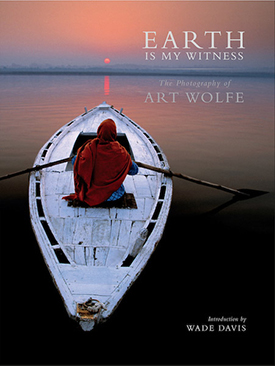
Art Wolfe’s book is titled “Earth is My Witness." (Photo: courtesy of Art Wolfe)
As I said, I'm from Seattle. We don't swim up here, you know, the waters of Puget Sound are cold. So, I'm floundering around in the South Pacific, and a baby humpback whale is circling around its mother. The mother comes over and checks me out. I had no sense of danger. I mean, historically I never have never heard of one injuring a person. But however, in that same shoot their whale has to sort of emerge for a couple of minutes and then it comes up every seven minutes, and when it comes up I'm trying to swim as close as I can to where it would hit the surface to get a better shot. And I guessed a little too effectively, and the whale looked like at one point it was coming up right under me, and as it turned out it was about six or seven feet away. And then its tail nearly slapped the face mask off me. That's a memorable moment for me.
CURWOOD: Indeed. [LAUGHS] Hey, um, to what extent are you an advocate of conservation?
WOLFE: Very strong advocate. I mean I've got a list of environmental groups that we've supported with our photos, and we never really do it for the money. It's just because we believe wholeheartedly all those groups are what we need now even more than ever, and if my photos can support them and help them or bring greater exposure to their stories, I feel honored and obligated. I think the word “obligated” is the most appropriate word to use.
CURWOOD: Tell me why you arranged these photos in sections based on physical geography rather than your career timeline?
WOLFE: Well, I didn't want this book to be a retrospective because I'm still very active, and I plan to be for the next 20 years. So, we struggled with this. We don't call this a book “a retrospective”. We're calling it “a opus”, I guess, kind of my favorite photos taken to this date. But it also is a complex subject, arranging a book, because of the broad nature of the material that would be in it. You've got cultures. You've got abstracts. You've got wildlife. You've got landscapes, and how to make sense of that, we finally settled upon biomes. That to put the animals and the landscapes and the abstracts of the Arctic in one group and lump that in with the Antarctic seems logical. Island, ocean, seems logical, you know, tropical, subtropical, forest seem like a logical division. It was just a matter of how do we make visual sense of such a variety of imagery.
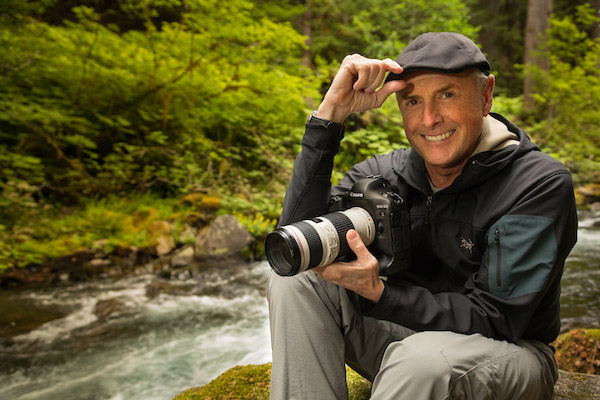
Art Wolfe is an award-winning nature and culture photographer and host of the television series, “Travels to the Edge.” (Photo: courtesy of Art Wolfe)
CURWOOD: So, what is the one picture that you're really itching to take one? One photograph you really want to make.
WOLFE: Yeah, there's a shot that I've had in the back of my mind for over 10 years and it's a extraordinarily beautiful tree that grows on an extraordinarily difficult island to get to. It's an island by the name of Socotra. It's halfway between Yemen and Somalia in the middle of the Indian Ocean, and one of the reasons the tree is such an intrigue for me is that it's so remote, and the trade winds doesn't allow the seeds of other trees to infiltrate this island, and so consequently these trees that grow on this island look outer worldly, and for a tree book I'm working on it would have been a perfect subject. However, you have to pass through Yemen to get to it, and last year the Yemenis rebels, you know, shot a rocket at a Navy ship, and we took out their communications towers. It's not a really good time to be American passing through Yemen.
CURWOOD: Hey, before you go, Art, do you have any tips for those of us who want to take pictures, especially for those of us who go out into nature or go to exotic places as the saying is, “bring back pictures and leave only footsteps”.
WOLFE: I say to people that you first have to care about the subject; otherwise, we're not going to care about it. You know, if you go out there and you're just randomly documenting a subject but you have no interest or emotional attachment to it, I think it shows, and photographers photograph for an audience. It's no different than why writers write or dancers dance. We all want to cultivate an audience and inspire them, educate them, and that's what I try to do with my work. But the most effective ones are where I'm deeply committed to the subject, and I think it comes across ultimately to my audience.
CURWOOD: Art Wolfe is an award-winning nature and culture photographer and host of the television series "Travels to the Edge". Art, thanks so much for taking the time with us, and thank you for publishing "Earth is my Witness"
WOLFE: My pleasure.
Links
Living on Earth wants to hear from you!
Living on Earth
62 Calef Highway, Suite 212
Lee, NH 03861
Telephone: 617-287-4121
E-mail: comments@loe.org
Newsletter [Click here]
Donate to Living on Earth!
Living on Earth is an independent media program and relies entirely on contributions from listeners and institutions supporting public service. Please donate now to preserve an independent environmental voice.
NewsletterLiving on Earth offers a weekly delivery of the show's rundown to your mailbox. Sign up for our newsletter today!
 Sailors For The Sea: Be the change you want to sea.
Sailors For The Sea: Be the change you want to sea.
 The Grantham Foundation for the Protection of the Environment: Committed to protecting and improving the health of the global environment.
The Grantham Foundation for the Protection of the Environment: Committed to protecting and improving the health of the global environment.
 Contribute to Living on Earth and receive, as our gift to you, an archival print of one of Mark Seth Lender's extraordinary wildlife photographs. Follow the link to see Mark's current collection of photographs.
Contribute to Living on Earth and receive, as our gift to you, an archival print of one of Mark Seth Lender's extraordinary wildlife photographs. Follow the link to see Mark's current collection of photographs.
 Buy a signed copy of Mark Seth Lender's book Smeagull the Seagull & support Living on Earth
Buy a signed copy of Mark Seth Lender's book Smeagull the Seagull & support Living on Earth

